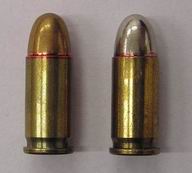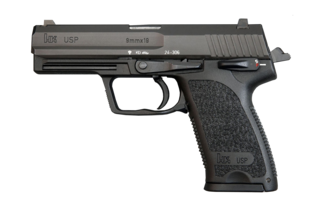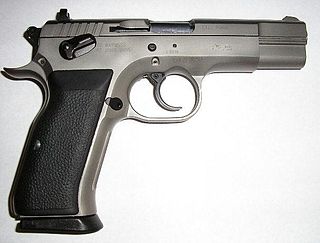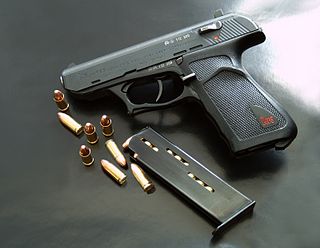
A derringer is a small handgun that is neither a revolver, semi-automatic pistol, nor machine pistol. It is not to be confused with mini-revolvers or pocket pistols, although some later derringers were manufactured with the pepperbox configuration. The modern derringer is often multi barreled, and is generally the smallest usable handgun of any given caliber and barrel length due to the lack of a moving action, which takes up more space behind the barrel. It is frequently used by women because it is easily concealable in a purse or a stocking.

A semi-automatic pistol is a handgun that automatically ejects and loads cartridges in its chamber after every shot fired. Only one round of ammunition is fired each time the trigger is pulled, as the pistol's fire control group disconnects the trigger mechanism from the firing pin/striker until the trigger has been released and reset.

The Beretta 950 is a semi-automatic pistol designed and manufactured by Beretta since 1952. It builds on a long line of small and compact pocket pistols manufactured by Beretta for self-defense. It was intended to be a very simple and reliable pocket pistol.

.32 ACP is a centerfire pistol cartridge. It is a semi-rimmed, straight-walled cartridge developed by firearms designer John Browning, initially for use in the FN M1900 semi-automatic pistol. It was introduced in 1899 by Fabrique Nationale, and is also known as the 7.65 mm Browning Short.

The SIG Sauer P220 is a semi-automatic pistol designed in 1975 by the SIG Arms AG division of Schweizerische Industrie Gesellschaft, and produced by J. P. Sauer & Sohn, in Eckernförde. It is currently manufactured by both SIG Sauer companies: SIG Sauer GMBH, of Eckernförde, Germany; and SIG Sauer, Inc., of New Hampshire, United States.

The USP is a semi-automatic pistol developed in Germany by Heckler & Koch GmbH (H&K) as a replacement for the P7 series of handguns.

The VP70 is a 9×19mm, 18-round, double action only, semi-automatic/three-round burst capable polymer frame pistol manufactured by German arms firm Heckler & Koch GmbH. VP stands for Volkspistole, and the designation 70 was for the first year of production, 1970.

The Heckler & KochP7 is a German 9×19mm semi-automatic pistol designed by Helmut Weldle and produced from 1979 to 2008 by Heckler & Koch GmbH (H&K). The P7M13, a variant of the P7 with a double-stack magazine, was produced until 2000.

The K100 is a 9×19mm semi-automatic pistol designed and built by Grand Power s.r.o. in Slovenská Ľupča, Slovakia located approximately 11 kilometers east of Banská Bystrica, Slovakia which is the region's major city.

Harrington & Richardson is an American brand of firearms and a subsidiary of JJE Capital Holdings. H&R ceased independent production February 27, 2015.

In American English, a pocket pistol is any small, pocket-sized semi-automatic pistol, and is suitable for concealed carry in a pocket or a similar small space.

The Sauer 38H or often just H was a small semi-automatic pistol made in Nazi Germany from 1938 until just after the end of World War II by J. P. Sauer & Sohn, then based in Suhl, Germany. The "H" in the model number is short for "hahn", referring to the internal hammer of the firing mechanism.

The Colt Model 1900 is a short-recoil operated "self-loading", or semi-automatic .38 caliber handgun introduced by Colt's Manufacturing Company at the turn of the 20th century. The M1900 was the first firearm to be chambered in .38 ACP and was the first handgun to utilize short-recoil operation.

The Smith & Wesson M&P is a polymer-framed, short recoil operated, locked breech semi-automatic pistol introduced in the summer of 2005 by the American company Smith & Wesson. It uses a Browning-type locking system. While targeted at law enforcement agencies, the M&P is also widely available on the commercial market.

A handgun is a firearm designed to be usable with only one hand. It is distinguished from a long gun which needs to be held by both hands and braced against the shoulder. Handguns have shorter effective ranges compared to long guns, and are much harder to shoot accurately. While most early handguns are single-shot pistols, the two most common types of handguns used in modern times are revolvers and semi-automatic pistols, although other handguns such as derringers and machine pistols also see infrequent usage.

Glock is a brand of polymer-framed, short recoil-operated, locked-breech semi-automatic pistols designed and produced by Austrian manufacturer Glock Ges.m.b.H.
Llama Firearms, officially known as Llama-Gabilondo y Cia SA, was a Spanish arms company founded in 1904 under the name Gabilondo and Urresti. Its headquarters were in Eibar in the Basque Country, Spain, but they also had workshops during different times in Elgoibar and Vitoria. The company manufactured moderate-priced revolvers and self-chambering pistols in a wide variety of models. These were popular mainly in the European and Latin American export market, as well as domestically in Spain.

The Tanfoglio Combat or Standard, also known as T(A)95 or EAA Witness Steel, is a modified clone of the Czech CZ-75/CZ-85 pistol. It is made in Gardone Val Trompia near Brescia, Italy by Fratelli Tanfoglio S.N.C.

The HK P9 is a semi-automatic pistol from Heckler & Koch in 9×19mm Parabellum, .45 ACP, and 7.65×21mm Parabellum and the first to use a variation of H&K's roller delayed blowback system in a pistol format and polygonal rifling now common in H&K designs.




















